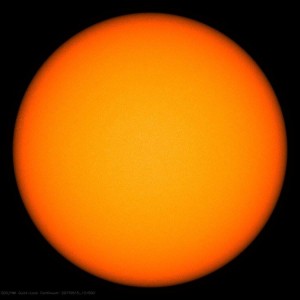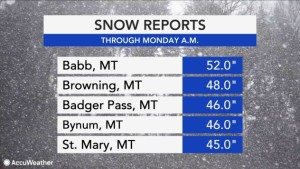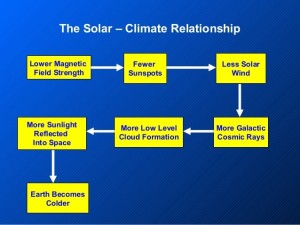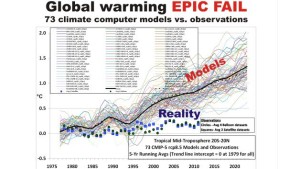I am not sure this is happening but it’s worth considering given the current state of sun spots.
Theodore White
Global Cooling: 2020s, 2030s & 2040s
The Sun’s Grand Minimum: October 2019
‘Prepare For Early Winter in the Northern Hemisphere’
by Theodore White, astromet.sci
By the time those who claim that ‘man-made global warming’ causes climate change, the weather of global cooling under the Sun’s Grand Minimum will have made a mockery out of that total fiction of anthropogenic global warming.
For years, the proponents of man-made climate change have failed to notice the altered jet streams; the increasing cloudiness worldwide; the heavy torrential rains and floods; snowfall in the Sahara Desert and the magnified strength of monsoons, cyclones and hurricanes.
They deny that the Earth has been cooling while they continue to believe in the multiple failed predictions of the United Nations’ Intergovernmental Panel on Climate Change (IPCC) which uses computer climate models that have not predicted one single climate or weather event accurately in over 30+ years.
These same climate models are unable to predict seasonal weather and climate.
They cannot forecast if a coming season will be early, on time, or late, but somehow are able to project years and decades into the future by claiming rising sea-levels and an ever-hotter Earth that is caused by ‘man-made climate change?’
How is that possible?
Those who believe in ‘man-made global warming’ will be among the first victims of the Sun’s Grand Minimum and climate of global cooling.
That’s because they will have wasted many years believing in something that does not exist while not preparing for something that does exist – and that is global cooling and the Sun’s powerful quiescent phase.
If you live on a coastline or in a floodplain, it is wise to relocate as the heavy and near constant rainfall of global cooling is a direct threat to you and your family in the years ahead.
Those living at the base of mountains are also urged to also move further away due to the threat of avalanches because of the extremely unstable heavy snow conditions that is part of the climate and weather of global cooling.
‘EARLY WINTER 2019-2020’
The record-breaking September snowfall in the American northwest signals the coming early winter season of 2019-2020 that I have forecasted.
The late winter of 2018-2019 arrived as I forecasted when the month of March 2019 saw mid-winter conditions.
This coming new winter will be earlier than normal according to my astrometeorological calculations.
For the United Kingdom, there will be increased atmospheric blocking over the North Atlantic that will see a cooler autumn 2019 leading to heavier snowfall and a cold season as the early winter sets into gear.
The first two weeks of October will be cooler than normal across northern Europe and Scandinavia.
As more cold and snowy events take place in October into early November, I have calculated that official winter for the northern hemisphere will begin on November 25-26, 2019.
This starts the first third of winter, which will take place from Nov. 25/26 to December 21, 2019. There will be significant snowfall in many regions in late November and the first two weeks of December.
A snowstorm during the second week of December 2019 – before Christmas – will strike Ontario, Canada, the Ohio Valley, New York States, Pennsylvania, and the Mid-Atlantic and Northeastern states.
The second third of winter – which will see freezing mid-winter conditions – extends from Dec. 21, 2019 to January 13, 2020.
It features colder-than-average temperatures, heavy snowfall and ice for the Midwest, Southeast and another snowstorm for Mid-Atlantic and Northeastern state during the second week of January 2020.
The last third of winter extends from Jan. 13th to February 8, 2020, according to my forecast and will see ice storms in the Midwestern and Southeastern states with another major snowstorm during the first week of February for the Mid-Atlantic and Northeastern states.
Temperatures will begin to rise in February in much of the nation, especially the West and Southwestern U.S., however, February will see freezing rain and icy conditions for the lower Midwest and southeastern states.
All in all though, I have calculated that spring 2020 weather conditions will be 36 to 40 days earlier-than-normal with warmer-than-average temperatures the second half of February 2020 and warming faster in March and April 2020.
These are astronomical causes that will see a warmer-than-normal solar year of 2020 that will be wetter and more humid during the spring and summer months of next year.
Meanwhile, the signs of an early winter 2019-2020 in the northern hemisphere made a major appearance in September 2019 over the northern rockies in Canada and the United States, where we find the state of Montana still recovering from the historic snowfall it received.
That snowstorm not only shattered September records, but was also one of their heaviest snowstorms of all-time according to the National Weather Service.
The historic snowstorm stunned residents of the northern Rockies as the heavy, wet snow and high winds caused widespread power outages, tree damage and ruined farmers crops.
The top snow total from the shocking winter storm was 52 inches about 10 miles south of the Canadian border in Babb, Montana.
Five additional locations in northwest Montana tallied up more than 40 inches of snow.
“This has never happened – ever,” said Ray Greely, a meteorologist with the National Weather Service in Great Falls, Montana on the September snowfall.
The city saw 9.7 inches of snow fall on September 28, 2019 which is highest one-day September snow amount in Great Falls history.
Greater amounts of snow fell in other areas in Montana as Browning got 4 feet of snow; the Dupuyer region received 37 inches and Heart Butte got 34 inches of snow.
Weather history was also made in Missoula, where the city broke its September snowfall record of 1.5 inches that was set back in 1934.
Spokane, Washington received 1.9 inches of snow on September 28, 2019 as the city broke its monthly record for September, set back in 1926, of 1.4 inches.
Meanwhile, record cold temperatures gripped parts of the Canadian and American Northwest.
Great Falls, Montana experienced a record number of hours with freezing temperatures to end the month of September.
Temperatures were 32 degrees or lower for 65 consecutive hours from Sept. 27-30, according to the National Weather Service (NWS.)
That’s the city’s most consecutive hours with temperatures at or below 32 degrees in the month of September in records dating to 1937.
Tuesday’s low in Great Falls, Montana, was just 9 degrees, which ranks as their coldest temperature ever recorded so early in the fall season dating to 1886.
Although not all-time record cold, daily record lows were broken in several other locations in the Northwest.
Cut Bank, Montana, set daily record lows of 6 degrees on Sept. 30, and 1 degree on Oct. 1.
Astoria, Oregon (35 degrees) and Olympia, Washington (29 degrees) both tied daily record lows on October 1st.
Montana’s Farm & Rancher network reported October 4, 2019 that:
“People along Montana’s Rocky Mountain Front continue to dig out following last weekend’s snowstorm that dumped as much as four feet of snow in some areas.
“We were able to get feed up to them this afternoon” said Gene Curry, whose family ranch is near Valier and had cattle on summer pasture near Browning.
“We took a big front wheel assist tractor and bale processor and hauled some hay up. The highway is bare but that’s the only thing is bare.”
He says even with death losses expected, another negative effect for ranchers is lost performance in this year’s calf crop which is headed to market soon.
“Instead those calves gaining weight now when they should be, you know, they should be just putting on pounds like crazy they’re losing weight here for a few days and you just never gain that back” said Curry.
“So, it just compounds. You know, you come in with lighter calves, they’re worth less.”
Ranchers weren’t the only ones impacted. Keven Bradley and family farm north of Cut Bank and still had one-third of their wheat crop yet to harvest when the snow began to fly.
“The quantity probably and the quality is going to be affected for sure” said Bradley. “There was a lot of the acres that didn’t get swathed, and so that even makes it more difficult to get it up off the ground.”
With farmers and ranchers already facing the stress of low livestock and commodity prices, this early winter storm is one they could have gone without
In the snowstorm’s aftermath, producers who suffered crop and livestock losses will be working with their respective associations like the Montana Grain Growers Association and Montana Stockgrowers Association to see what disaster help is available.”
The extreme weather start to the Fall season of 2019 are part of what I’ve long forecasted and that is the new climate era of global cooling under the Sun’s Grand Minimum which some people are still in denial about due to their belief in the false doctrine of ‘man-made global warming.’
That false belief is being challenged by the real-world weather and climate events taking place around the world as the Sun heads deeper into its quiescent state as I’ve long said it would at the dawn of the new decade of the 2020s.
Expect more irregular seasons marked by unusual weather events which is a mark of the climate of global cooling.
As the Sun continues its dive into its powerful quiescent phase, the altered polar jet stream and subtropical jet in both hemispheres will see significant change in temperature because of increased cloud cover, cooling the Earth.
Heavy amounts of precipitation from a cooled troposphere will mean unusual amounts of hail, snow and rainfall causing major disasters worldwide – especially greater floods, both urban and rural.
This early winter season is a very good time to practice your prep for the climate and weather of global cooling that will dominate the 2020s, 2030s and 2040s.
Those in denial about the Sun’s Grand Minimum and climate of global cooling who fail to prepare will have only themselves to blame as they will be among the victims who will learn the hard way that it is the Sun that causes all climate change.
It is time to prepare. Even if this does not happen, it is wise to consider.



